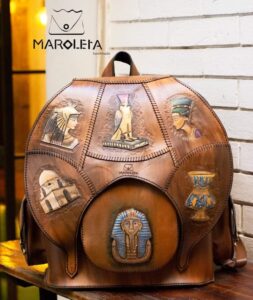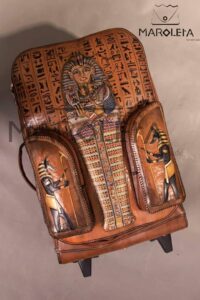Marwa Kabbary does her best to encourage tourism through her leather products.
She uses ancient symbols to make leather products that educate tourists about Egypt’s history.
Kabbary, an agriculture engineer by profession, is addicted to bags made of natural leather.
“The problem was, however, that natural leather is very expensive,” she told the Egyptian Mail.
This was why she decided to take a course in the making of bags and other products from natural leather, with an eye on making products for herself and her family members.
Her initial successes in making the products, using natural leather, encouraged her to start her own natural leather bag brand.
Kabbary also participated in a number of crafts competitions, including most recently in the ‘I’m Egypt’ contest which was organised by the Egyptian Crafts Association.

Before going to the fair, however, she wanted to distinguish her products from others brought by other leatherworkers to the event.
This was why she decided to include an element related to the ancient Egyptian civilisation in the products.
She also used symbols belonging to Egypt’s Islamic and Coptic civilisations in the products, distinguishing them even more.
“I opted for putting these different symbols on the back of the bags I made,” Kabbary said.
She did this by joining strips, squares, and triangles, a process called patchwork.
By so doing, she wanted her bags to be an expression of different aspects of the Egyptian civilisation.
“I wanted the bags to speak for themselves,” Kabbary said. “I wanted them to say ‘I am Egypt’.”
Kabbary won the first place in the competition at the state level.
Her success focused her mind on the two goals of her products: practicality and attraction.
She wanted to create practical products that serve clients best and also attract tourists and educate them about the Egyptian civilisation.
Egypt’s ancient civilisation, she said, is a magnet for non-Egyptians who are infatuated with this civilisation.
Kabbary’s selection of natural leather boils down to its value and strength.
“Natural leather is a very rich material that gives products value,” Kabbary said.
Kabbary does not need to make any additions to the leather. In this, she said, natural leather is different from artificial leather which does not live as long as the natural one and cannot stand alone.
In making her products, Kabbary uses a wide range of tools, such as cutting boards, cutters, hammers, scissors, painting brushes, iron rulers, and needles.
She starts making her products by drawing a sketch of the aspired product and then making a patron.
Kabbary then picks up the material she will use, before she makes the design and cuts the leather to fit the design and the patron.
She then starts working on the leather by burning, hammering, and dyeing it. She also puts the zippers and makes the pockets of the bag before she finishes the sewing process to make the bag complete.
 The time Kabbary takes to make a bag depends on its design.
The time Kabbary takes to make a bag depends on its design.
In 2021, Kabbary won the third place in a competition organised by the Supreme Council of Culture.
She designed a travel bag that invited the attention of almost all visitors in the competition which was called ‘Creative Crafts’.
She got the idea of the bag from the mummies’ parade that was held through the streets of Cairo last year.
She modeled the wheels of the bag on the casket of Tutankhamun. She also placed a photo of Anubis, the ancient god of the dead, on the sides of the bag, as if it is there to protect Tutankhamun.
Most of Kabbary’s other bag designs were inspired by the ancient Egyptian civilisation.
Her products include back bags, travel bags, cross bags, pockets and others.
“I hope I can use my products to spread information about the Egyptian civilisation,” Kabbary said. “By being on the bags, the symbols of this civilisation can travel around the world, in the hands or on the backs of my clients.”






Discussion about this post